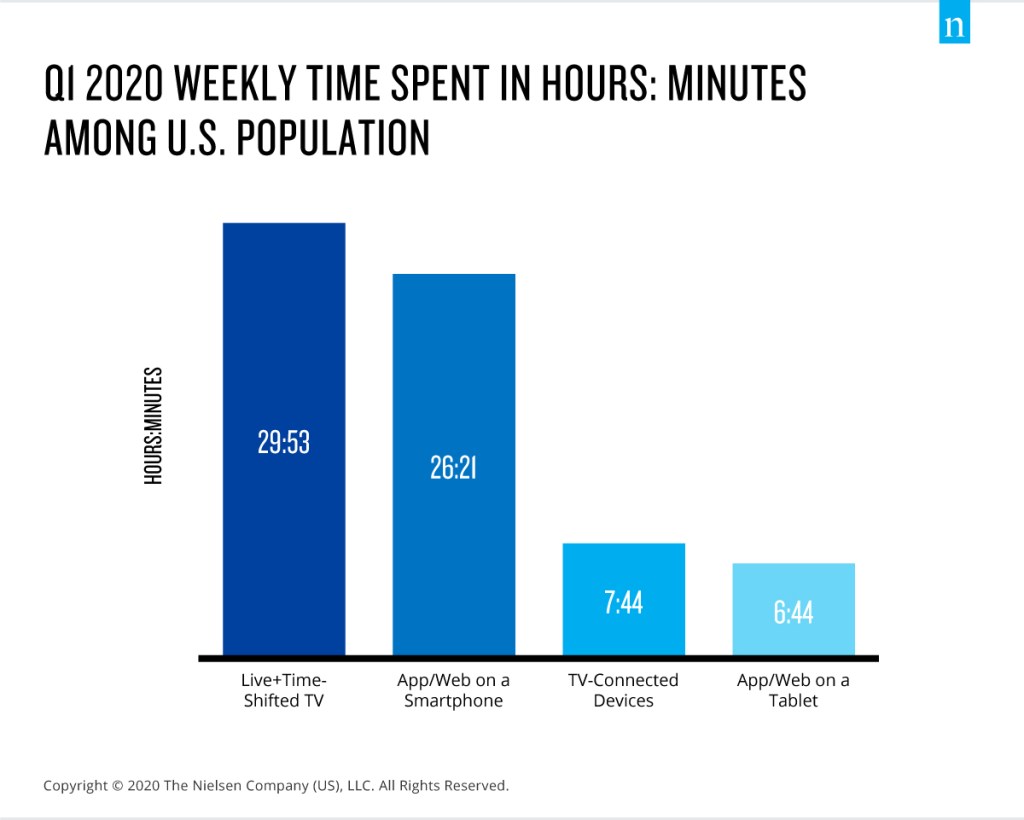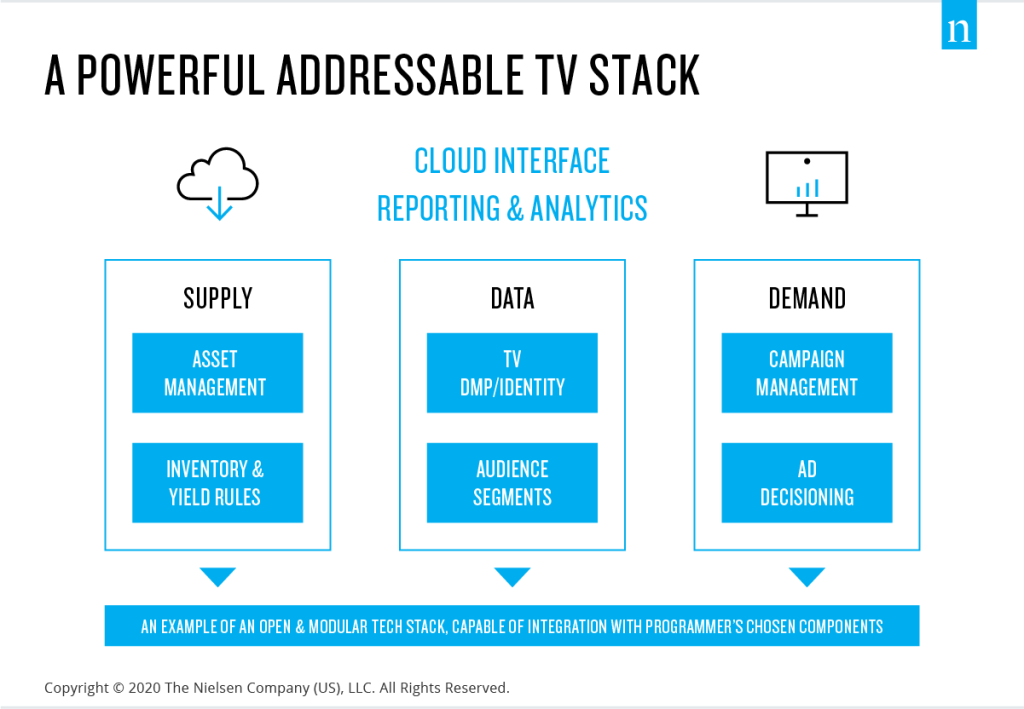Stacking Your Cards Right With a Powerful Tech Stack

Planning and executing TV advertising used to be simple, running on the same formula for many years. If 2020 has taught us anything, it’s that we need to adapt to the shifting world we live in. Following years of TV set evolution and advancements in digital marketing, the bar has been raised for what marketers and viewers expect when it comes to advertising on the TV glass. Marketers want rich, attribution-based data to inform their marketing plans, and viewers demand a seamless, custom experience from the moment they power on their devices.
Marketers continue to spend money on linear TV because that’s still where consumers are spending most of their time. In fact, we spend nearly 30 hours a week watching linear and time-shifted—that’s more than any other media type—which is even more impactful given TV’s powerful scale, reaching 85% of the U.S. population. In recent years, the industry has been a buzz about addressable TV—that is the data, control and targeting of digital advertising applied to the reach and frequency of TV advertising. Advancements in technology are finally at the point where addressable TV at scale is now imminent. But what is addressable TV all about, and what does it require from the very start in order to be successful in the long term?

DIGITAL-LEVEL DATA WITH THE SCALE OF TV
Addressable TV offers the best of both digital and traditional television. Speed, precision and data-driven targeting are some of digital’s biggest draws for marketers who need to quickly adapt to changing consumer sentiments. Enabled by the rapid adoption of internet-connected devices like smart TVs, now in 54% of US homes, linear advertising can operate with the agility of digital as well as leverage similar reporting capabilities.
Modern advertisers can practice what their predecessors predicted: personalized advertising delivered to specific households (beyond age and gender proxies) instead of catering broadly to entire program audiences. For everyday viewers, this means they could be watching the same live primetime program as their neighbor but see advertisements tailored to their preferences during commercial breaks. For example, an urban dog owner might see an ad for organic puppy chow whereas an expecting couple might see a commercial for diapers. Advertisers benefit from connecting with viewers who are more likely to purchase their products and programmers unlock inventory opportunities by enabling premium ad space to be executed across multiple advertisers. And because commercials reach the right audience with tailored messaging, viewers have a more personalized and satisfying experience.
A PROVEN TECH STACK IS KEY FOR ADDRESSABLE TV
Before reaching the scale of traditional TV, addressable TV must be built on a solid tech stack. A tech stack is simply an alignment of all of the technology components that help an addressable TV platform run smoothly from end-to-end. This includes data management platforms (DMPs) that allow advertisers to select audience segments beyond traditional demos, to TV chipsets that bring addressable software across different TV models and manufacturers, to automatic content recognition (ACR) technology that recognizes when to insert an ad in live programming, to privacy management software that protects viewers.

Once the necessary tech components are in place, a rigorous testing phase follows to guarantee flawless execution. This prevents common addressable issues like blackouts, buffering, overlapping of ads, or unsafe brand placements. We all know how aggravating it can be to wait for an ad to load, and advertisers know that a poorly placed ad can be devastating to brand image. With addressable TV, the ad experience becomes more relevant by connecting audiences with products they care about, even potentially cutting back on the number of ads due to more sophisticated frequency management and, in a perfect world, the creative will be tailored to the viewer’s needs making the advertising experience more valuable and enjoyable. None of this can be accomplished until the technology is proven reliable.
A general rule of thumb when commercializing an addressable TV platform is to start with a buildable foundation before attempting to scale. A tech stack is ready when it 1) reduces complexity across existing TV workflows, 2) offers a seamless viewing experience and 3) can bring transparency in the TV marketplace.
3 Components of a Successful Addressable Tech Stack:
#1 Reduced Complexity
Addressable TV does not operate in a vacuum, but needs to be integrated within the advertising ecosystem’s existing workflows and technology. In particular, for addressable TV to succeed at scale, buying friction (difficulties associated with actually buying addressable TV inventory) needs to be removed through aggregation of inventory for buyers, ease of using targeting data sets, and the ability to automate campaign operations and performance across multiple distribution platforms.
Addressable TV should aim to simplify and automate existing workflows rather than create more confusion. No matter how strong the technology, if the decisioning mechanisms used to determine the lineup of dynamic ad insertions are difficult to implement, and cause friction across existing processes, then the offering will be difficult to scale.
With that in mind, a solid tech stack needs to be built from the ground up on open APIs that enable TV networks and players to easily “plug and play” with their current partners across the digital and TV landscape. Rather than reinventing the wheel, a successful addressable platform is interoperable to enable advertisers and programmers to utilize existing third party infrastructure such as DMPs, DSPs, SSPs, ad servers and more. When a platform is not dependent on certain manufacturers, devices, or models, it allows for an open and flexible approach to delivering content across addressable inventory. Whether a viewer is streaming content over a set-top-box, digital antenna, or virtual multichannel video programming distributor (vMVPD) ads can be delivered across them all, in real-time.
#2 Seamless Ad Insertion
A flawless end consumer viewing experience through seamless ad insertions is a quintessential part of any addressable TV platform. Automatic Content Recognition (ACR) is one of the core building blocks of the tech stack, since it has largely to do with the how an ad is inserted into live linear TV content and is a key differentiator in determining if the consumer has a seamless experience. Video ACR as it relates to addressable TV is the technology that not only is key to recognizing what’s being played on the TV glass, but also ensuring with high precision and accuracy the results that are driving key business decisions such as real-time ad replacements.
Powerful video ACR allows for early detection of when ads should play (specific ad breaks), where they should be delivered (households that meet predefined criteria) and which ads should be lined up for real-time ad insertions (optimized based on brand or creative). Cutting-edge video ACR is needed to handle natural broadcast delays that occur in TV programming like live sports. With a reliable video ACR capabilities incorporated in the tech stack, addressable TV is an accurate and trustworthy solution that the TV ecosystem can add as a cornerstone in their media mix.
#3 Trust and Transparency
Establishing trust and transparency with consumers through ethical data practices is at the core of any successful addressable TV platform. Consumer privacy is just as critical as creating a more personal, enjoyable advertising experience. A lack of secure and anonymous data collection impacts the whole addressable ecosystem, right from the very onset.
In addition to gaining consumer trust, the addressable TV space also faces the daunting challenge of establishing trust across the entire existing TV ecosystem. For TV programmers, advertisers and agencies to have confidence in buying and selling addressable ads, they need standardization and transparency in how they measure and track success. For addressable advertising to be operationally successful, ad insertion execution should be seamless and the buying process itself needs to be streamlined across all of the different places where addressable TV inventory is bought and sold. There are three primary metrics that should be considered when tracking success, these KPIs are table stakes to bring trust and transparency to addressable TV and include active TV rate (the rate at which addressable devices are actively replacing ads across networks), identity match rate (the success of ads matching their target audience) and ad replacement success rate (the rate at which ads are replaced flawlessly).
Without standards, many variables exist that would likely differ across MVPDs (the various satellite and cable providers) and smart TV OEMs (the original equipment manufacturers producing the TV sets), including target segment definitions and universe estimates, technical success factors for ad replacement success rate and more. To streamline the buying process for advertisers and enable consistency across different addressable platforms, industry standards will need to be developed. For all advertisers, that means having trusted partners who provide transparency to every campaign that is measurable and more importantly comparable across addressable platforms.
As smart TVs continue to experience massive market penetration and linear TV advertising transforms to a more targeted experience, a focus on frictionless workflow, delivery precision, and transparency will help move the addressable ecosystem forward. A powerful tech stack will go a long way in helping build a more scaled addressable TV future.
This article originally appeared on www.nexttv.com.



